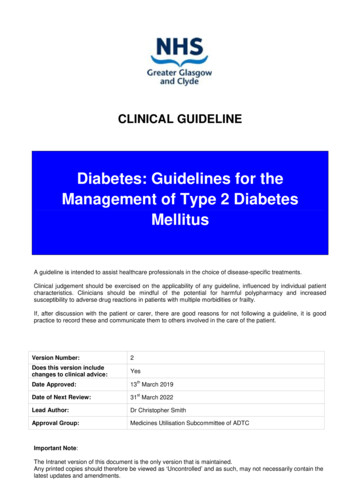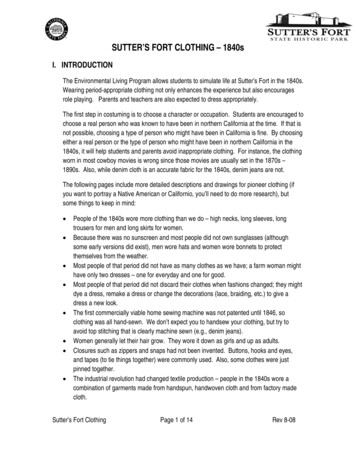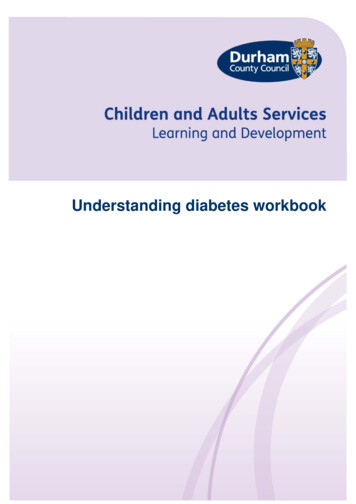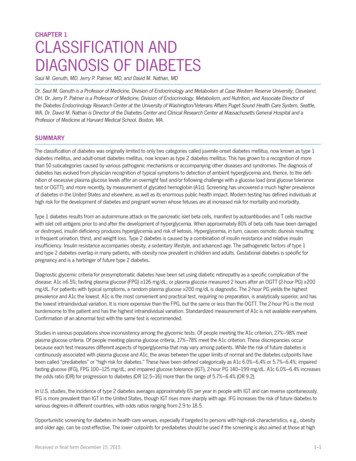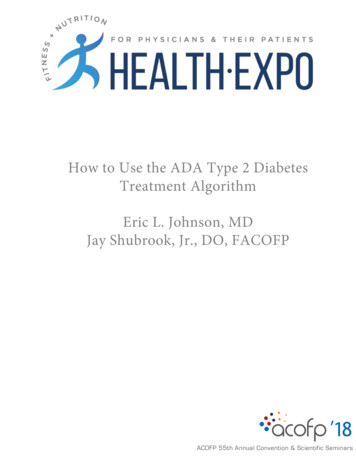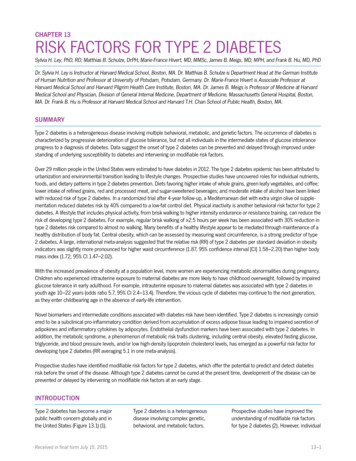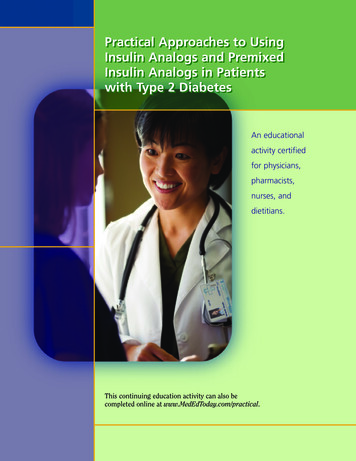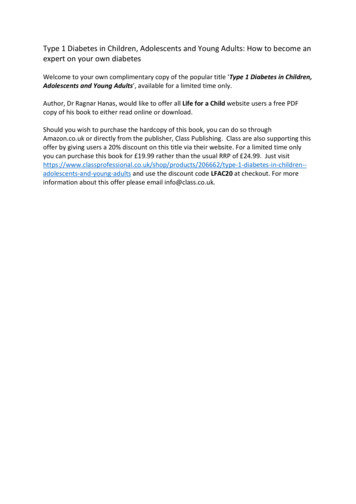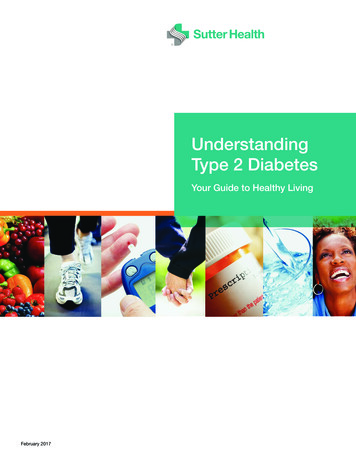
Transcription
UnderstandingType 2 DiabetesYour Guide to Healthy LivingFebruary 2017
Understanding Type 2 DiabetesIf you have diabetes, prediabetes or high blood glucose (bloodsugar)—or if you simply want to learn more about diabetes—this book is for you. Inside, you will find the basics of diabetescare, plus tools to help you manage your diabetes. As youread, keep in mind that diabetes is a complex disease. Theknowledge and skills you need for diabetes self-managementtake time to learn. As you learn, you will be better equippedto adjust your lifestyle for better health. You are not alone.You have the support of a health care team that includes yourhealth care provider and other diabetes experts.7 Self-Care BehaviorsThe American Association of Diabetes Educators has a list ofseven key behaviors, known as the AADE7TM Self-Care Behaviors,to help patients successfully manage type 2 diabetes and preventcomplications. These include: healthy eating, being active,monitoring, taking medication, problem solving, reducing risksand healthy coping. When making healthier lifestyle choices, ithelps to set goals in each of these seven key areas. Your healthcare provider can help you develop a diabetes management plan.
Table of ContentsWhat is Diabetes? . . . . . . . . . . . . . . . . . . . . . . 2Hyperglycemia (high blood glucose) . . . . . . . . . 25What Causes Glucose Levels to Become Elevated . . 2Managing Sick Days . . . . . . . . . . . . . . . . . . . . . 26Types of Diabetes . . . . . . . . . . . . . . . . . . . . . . . . 3Diagnosis of Diabetes . . . . . . . . . . . . . . . . . . . . . 3Screening for Diabetes . . . . . . . . . . . . . . . . . . . . 4Risk Factors for Type 2 Diabetes . . . . . . . . . . . . . 4Reducing Risks . . . . . . . . . . . . . . . . . . . . . . . . 27Complications and Symptoms of Diabetes . . . . 27Heart Disease and Stroke . . . . . . . . . . . . . . . . . 29Caring for Your Feet . . . . . . . . . . . . . . . . . . . . . . 30Healthy Eating . . . . . . . . . . . . . . . . . . . . . . . . . 5Protecting Your Teeth and Eyes . . . . . . . . . . . . 31Make Healthy Choices . . . . . . . . . . . . . . . . . . . . 5Preventing Kidney and Nerve Disease . . . . . . . 31Choose the Right Portions . . . . . . . . . . . . . . . . . 5Maintaining Your Sexual Health . . . . . . . . . . . . . 32The Plate Method . . . . . . . . . . . . . . . . . . . . . . . . 6Immunizations . . . . . . . . . . . . . . . . . . . . . . . . . . 33Carbohydrate Counting . . . . . . . . . . . . . . . . . . . . 7Diabetes and Pregnancy . . . . . . . . . . . . . . . . . . 33Guidelines for Reading Food Labels . . . . . . . . . . 9Smoking . . . . . . . . . . . . . . . . . . . . . . . . . . . . . . . 33Being Active . . . . . . . . . . . . . . . . . . . . . . . . . . . 10Healthy Coping . . . . . . . . . . . . . . . . . . . . . . . . 34Exercise Offers Important Benefits . . . . . . . . . . 10Stress . . . . . . . . . . . . . . . . . . . . . . . . . . . . . . . . 34Types of Physical Activity . . . . . . . . . . . . . . . . . 10Recognizing Depression . . . . . . . . . . . . . . . . . . 35Preparing for Exercise and Physical Activity . . . 12Diabetes Burnout . . . . . . . . . . . . . . . . . . . . . . . . 36How to Create a More Active Lifestyle . . . . . . . 13Taking Action . . . . . . . . . . . . . . . . . . . . . . . . . . . 36Exercise Precautions . . . . . . . . . . . . . . . . . . . . . 13Appendix . . . . . . . . . . . . . . . . . . . . . . . . . . . . . . 39Monitoring Your Blood Glucose . . . . . . . . . 15Diabetes Health Record . . . . . . . . . . . . . . . . . . 39Blood Glucose Goals . . . . . . . . . . . . . . . . . . . . 15Blood Glucose Record . . . . . . . . . . . . . . . . . . . 41A1C . . . . . . . . . . . . . . . . . . . . . . . . . . . . . . . . . . 17Carbohydrate Choices . . . . . . . . . . . . . . . . . . . . 42Non-starchy Vegetables . . . . . . . . . . . . . . . . . . 46Taking Medicine . . . . . . . . . . . . . . . . . . . . . . . 18Proteins . . . . . . . . . . . . . . . . . . . . . . . . . . . . . . . 47Oral Medicine . . . . . . . . . . . . . . . . . . . . . . . . . . 18Fats . . . . . . . . . . . . . . . . . . . . . . . . . . . . . . . . . . 49Injectable Medicine . . . . . . . . . . . . . . . . . . . . . . 20Disposal of Medical Waste . . . . . . . . . . . . . . . . 52Insulin . . . . . . . . . . . . . . . . . . . . . . . . . . . . . . . . 21Diabetes Resources . . . . . . . . . . . . . . . . . . . . . 53Problem Solving . . . . . . . . . . . . . . . . . . . . . . . 23Hypoglycemia (low blood glucose) . . . . . . . . . . 23Social Media Sites . . . . . . . . . . . . . . . . . . . . . . 53Mobile Apps . . . . . . . . . . . . . . . . . . . . . . . . . . . 54
What is Diabetes?Diabetes is a medical condition that develops when your body cannotregulate the level of glucose (sugar) in the blood. As a result, your bloodglucose (blood sugar) levels become higher than normal. When bloodglucose climbs too high, this affects the cells and tissues of your body.As a result, you can have uncomfortable symptoms—such as fatigue, blurryvision or extreme thirst. But that’s not all. Over time, unstable blood glucosecan lead to serious and harmful complications.What Causes Glucose Levelsto Become Elevated1Glucose is made by the liver.2Glucose is also made in the gut by the breakdownof carbohydrates from food and drinks.3In response to glucose, the pancreas makesand releases insulin.4Glucose and insulin flow throughout thebloodstream to all the parts of the body.5Insulin attaches to cells throughout the body,which open “channels” that allow glucose tomove from the bloodstream into the cells.6The cells in the body use glucose for energy.7Without a trigger by insulin, the channels remainclosed, and glucose is unable to enter the cells.8This causes glucose levels in the body tobecome elevated.876122345
Types of DiabetesType 1 diabetesType 1 diabetes occurs when the immune systemmistakenly attacks the pancreas, damaging it sothat it can no longer make insulin. Without anyinsulin, the glucose level in the body becomeselevated. People with type 1 diabetes need to takeinsulin to manage the disease.This type of diabetes most commonly strikeschildren, teens and young adults, but it can occurat any age. To date, scientists do not know whatcauses type 1 diabetes, and type 1 diabetes cannotbe prevented.This is the most common type of diabetes. It canoften be managed with healthy eating, exercise andprescription medicine (pills). Some people mayalso need insulin injections to manage the disease.PrediabetesPrediabetes occurs when blood glucose levelsare higher than normal, but not high enough to bediagnosed as diabetes. Prediabetes increases therisk of developing type 2 diabetes. Research hasshown that healthy eating and lifestyle changes canhelp delay or prevent the onset of type 2 diabetes inpeople with prediabetes.Gestational diabetesType 2 diabetesType 2 diabetes occurs when the body becomesunable to use the insulin you make. The pancreasis then unable to make enough insulin to overcomethe resistance. Without adequate insulin toovercome this resistance, the glucose level in thebody becomes elevated.Gestational diabetes, also known as GDM, is highblood glucose that first shows up during pregnancy.GDM occurs when the body becomes resistantto insulin due to the hormones from the placenta.It is usually diagnosed after the 24th week ofpregnancy. High blood glucose is harmful to boththe mother and her developing baby. Women whohave had gestational diabetes have a higher risk ofdeveloping Type 2 diabetes.Diagnosis of DiabetesIn-rangePrediabetesDiabetesFasting Blood Glucose (mg/dL)less than 100100-125126 or higherBlood Glucose two hours after a75 gram glucose tolerance test (mg/dL)less than 140140-199200 or higher200 or higher(in a person having symptoms)Random Blood Glucose (mg/dL)A1C (%)less than 5.75.7-6.46.5 or higherWithout clear symptoms of diabetes, test should be repeated to confirm diagnosis.3
What is Diabetes?Screening for DiabetesThe American Diabetes Association recommendsscreening all adults age 45 and older for diabetes.If a person is overweight or obese and has oneadditional risk factor (see table below) they shouldbe screened regardless of age. Screening may berepeated every three years. Discuss screening fordiabetes with your health care provider.Risk factors for type 2 diabetes Smoking Unhealthy eating Prediabetes Older age Overweight or obese Physical inactivity Family history of diabetes Ethnic populations that are athigher risk: African American,Latino, Native American, AsianAmerican, Pacific Islander4 Gestational diabetes or had a babythat weighed more than 9 pounds History of heart disease High blood pressure High-density lipoprotein (HDL)cholesterol less than or equal to 35 Triglyceride level greater than orequal to 250 Polycystic ovarian syndrome
Healthy EatingEating Right to Manage DiabetesHow you eat is very important for managing your health and yourdiabetes. There is no standard meal plan or eating pattern that worksfor all people with diabetes. Work with your healthcare providers tolearn what to eat, how much to eat and when to eat. This will help youmanage your blood glucose levels and your weight. It may also helplower your risk of heart disease and other diabetes complications.Make Healthy ChoicesAs often as possible, choose nutritious, lessprocessed foods. This can help you to achievea healthy weight and manage diabetes.These include: High-fiber foods such as whole grains, beans,fresh vegetables and fruits. Low-fat protein such as fish and seafood, soyproducts, fat free and low fat milk, cheeseand yogurt, poultry without skin and lean cutsof meat. Choose heart-healthy fats such as olive, canolaor peanut oil, avocado, nuts, and seeds insteadof butter. Eat fish twice a week, especially salmon andsardines, which contain omega 3 healthy fats.Choose the Right Portions How much energy (calories) you need dependson your age, gender, activity level and weightgoal (desire to lose, gain or maintain weight).Weight loss can lead to improved glucose levels. Fat is found in many foods and there are manytypes of fat. Choose heart-healthy fats inmoderation if weigh loss is desired.The following chart can help to estimate portion sizes.Visual Aids to Help You EstimatePortion SizeVisual Aids to Help Your Estimate1 cup baseball3/4 cup tennis ball1/2 cup computer mouse1/4 cup egg3 oz. 2 tablespoons deck of cardsPing-Pong ball Energy (calories) comes from 3 key nutrients: Carbohydrates turn into glucose, so spreadevenly through the day. Protein builds and maintains muscle, helpsyou feel fuller longer and helps keep yourblood glucose within range.Two methods to help with portion control are “theplate method” and “carbohydrate counting”.5
Healthy EatingThe Plate MethodThe plate method is a good way to plan wellbalanced meals that are limited in carbohydrates.Divide your food groups on a 9- to 10-inch plateas shown in the diagram.A common goal for meals may include two to fourservings of carbohydrates. More detailed guidesto help you choose the correct amount and type offoods to eat are on pages 7-9 and pages 42-51.General Guidelines:Breakfast A portion of whole grains, whole grain products(breads and cereals), lentils, dried beans,or starchy vegetables fits on one quarter ofthe plate. A portion of lean protein fits on one-quarter ofthe plate. A variety of colorful, non-starchy vegetables fitson half the plate. Include fruits and/or vegetables at every meal. A cup of milk or yogurt and/or a serving of fruitmay be eaten with the meal or saved for snack.Lunch* Use a small amount of heart-healthy oil forcooking or flavoring foods and/or add a few nutsor seeds to your meal. Use herbs and spices liberally. Choose a wide variety of types and colors offruits and vegetables, such as dark-green andorange vegetables and blue and red fruits.* The sandwich at lunch contains whole grainbread (one-quarter of the plate) and leanprotein (one-quarter of the plate).Dinner6
Carbohydrate CountingCarbohydrates are a main source of energyand are part of healthy eating. Countingcarbohydrates when you eat is a good way tomanage your weight and diabetes. However,eating too many carbohydrates can raise yourblood glucose to unhealthy levels. Eating theright kinds of carbohydrates in the right portionsis part of a healthy meal plan.Major carbohydrate foodgroups include: Starches, beans, starchy vegetablesFruit and fruit juicesMilkSweets, sweetened drinks, and snacksCarbohydrate ChoicesA carbohydrate choice is a serving of food thathas approximately 15 grams of carbohydrates.The more grams of carbohydrates you eat,the higher your blood glucose level willrise. Planning meals by limiting and evenlyspreading your carbohydrates through the daycan improve diabetes management. Thefollowing table shows the amount of food inone carbohydrate choice, that may be used forportion control.Please see page 42 in the Appendix for acomplete list of carbohydrate choices.15grams of carbohydrates 1 carbohydrate choiceCarbohydrate ChoicesStarchEach serving contains 15 grams of carbohydrate andabout 80 calories ½3 cup cooked whole grains (rice, quinoa, barley) ½ cup cooked beans and lentils ½ cup starchy vegetables (potatoes, peas, corn) ½3 cup cooked pasta and couscous (whole grain is best) 1 slice (1 oz.) bread (sprouted grain is best)FruitEach serving contains 15 grams of carbohydrate andabout 60 calories 1 small (4-5 oz.) piece of fruit 1 cup melon chunks ½ cup diced fruit ¾ to 1 cup berriesMilkEach serving contains 15 grams of carbohydrate andabout 90 to 120 calories 1 cup milk (reduced-fat and fat-free are best) 6 to 8 oz. nonfat plain or flavored “light” yogurt 1 cup fortified (calcium-enriched) soy milkOther CarbohydratesLimit theseEach serving contains 15 gramsof carbohydrate and variable amounts of calories ½ cup low-fat ice cream 2-inch square of cake or brownie (unfrosted) 2 small cookies (2 inches each) 1 Tbsp. sugar, honey, syrup, jam, or jelly 4 oz. of juice or sweetened drink7
Healthy EatingHow Much to EatChoose Healthy FatsWork with your health care provider to find the bestmeal plan for your particular health needs. Here aresome guidelines:Choose heart-healthy fats. Examples include:vegetable oil (olive, peanut, or canola), avocado,nuts, seeds, trans fat-free tub margarines, and saladdressing made with healthy oils. All fats are highin calories and may result in weight gain if eaten inexcess. Choose two to four carbohydrate choices permeal (30 to 60 grams). Choose up to one or two carbohydrate choicesat each snack (15 to 30 grams). Choose 4 to 6 ounces of lean protein in a day(about two decks of cards). Choose 1 to 2 tablespoons of heart-healthy fatevery day.Although there is no ONE single eating plan thatworks best for all persons with type 2 diabetes,research has shown the benefit of both the PlantBased and Mediterranean styles of eating. Bothplans recommend the following: Build meals using fresh vegetables, fruits andwhole grains. Limit or eliminate red meat Increased use of vegetable proteins from beans/legumes, nuts and seeds or from fish Decrease sodium and use fresh herbs and spicesto season foods Replace butter with healthy oils such as olive oilInclude ProteinEating enough protein not only helps you buildmuscle, but it helps keep your blood glucose stable.Choose plant proteins such as legumes and soyproducts, nuts and seeds. Choose lean animalproteins such as white-meat poultry (skinless);nonfat or low-fat dairy products; tenderloin cut ofpork and beef, and eggs (whole eggs, egg whitesand egg substitute).Avoid eating fatty protein such as sausage, salami,regular and full-fat cheese, ribs, bacon, and regularground beef.8Avoid unhealthy (trans and saturated) fats. Thesemay make insulin resistance worse and increaseyour risk for heart disease. Trans and saturated fatsare found in fatty meats, deep-fried foods, wholefat dairy products, pastries, poultry skin, cheese,cookies, sausage, sour cream, some crackers,creamer, half-and-half, and premium or full-fat icecream.See the expanded food lists on pages 42-51in the Appendix.More Tips for Healthy Eating Use measuring cups, measuring spoons, and afood scale for portion control. Drink unsweetened or noncaloric beverages, andwater. Limit alcoholic beverages, but if you do drink, besure to have with food or snack as it could leadto low blood glucose. Eat at the table with all screens (TV, computer,phones) off during the meal. If you tend to eat when bored, try an alternativenonfood related activity such as going for a walk,reading or talking with a friend.
Guidelines for ReadingFood Labels1 Start with the serving size All the listed nutrients are based on this serving size.1Nutrition FactsServing Size 1 cup (228g)Servings per Container 22 Check the calories The amount of Calories you eat affects your weight.Amount per serving2Calories 190Calories from Fat 45%Daily Value*345Total Fat 5gSaturated Fat 3gTrans Fat 0gCholesterol 30mgSodium 470mgTotal Carbohydrate 31gDietary Fiber 6gSugars 5gProtein 5gVitamin A 4%Calcium 20% Note that Servings per Container equals the numberof servings contained in the package.8%15% Fewer calories helps with weight loss3 Check the fat and sodium Keep Saturated Fat as low as you can Avoid Trans Fat10%20%20%Vitamin C 2%Iron 4%* Percent Daily Values are based on a 2,000-calorie diet.Your Daily Values may be higher or lower, dependingon your calorie needs. Limit Cholesterol Look for the lowest amount of Sodium4 Count carbohydrates Look at Total Carbohydrate per serving 1 Carbohydrate Choice 15 grams of carbohydrate Sugars are included in the total gramsof carbohydrate5 Choose more fiber, vitamins and minerals Look for the highest amount of Fiber Look for high amounts of vitamins and mineralsRead the ingredients to helpchoose healthy foodsThe ingredients are listed in order frommost to least9
Being ActiveBeing physically active helps to keep your blood glucose in a healthyrange. Physical activity (exercise) makes muscles contract, causingthem to absorb glucose for energy. This process happens much morequickly during physical activity than at rest.Exercise Offers ImportantBenefits Lowers fasting blood glucose and improvesinsulin action Lowers blood pressure Lowers cholesterol and triglyceride (blood fat)levels Lowers your risk for heart disease and stroke Relieves stress and can improve your mood Burns calories, which can help you manageyour weight Improves energy and ability to concentrate Helps you sleep better at nightTypes of Physical ActivityThere are three general types of exercise. Eachtype has unique health benefits, so you will wantto include a variety of activities in your weeklyroutine. Check with your health care providerbefore starting any exercise program.1Aerobic ExerciseAerobic exercise is any exercise that increasesyour breathing and heart rate for a prolongedperiod. Examples include brisk walking, swimmingand dancing. Aerobic exercise uses glucose and fats for fuel,burning calories and helping to manage weight.It also strengthens the heart and lungs andimproves circulation. If you haven’t exercised recently, start with fiveto 10 minutes of gentle aerobic exercise three ormore times per week. Gradually increase yourtime by five to 10 minutes. Aim for some type of aerobic activity at least30 to 60 minutes a day, three or more days aweek. Try not to skip more than one day. It maybe easier to divide this time. For example,consider taking a 10-minute brisk walk aftereach meal. Mild to moderate intensity exercise tends tolower blood glucose. More intense exercisemay cause an increase in blood glucose forone to two hours following exercise. Begin and end workouts with five minutes of aneasier-paced exercise to warm up and then tocool down.10
2Strength TrainingStrength training helps you lower glucose levels,build muscle, and lose weight. Also, exercise helpsimprove your strength and balance. Examples of strength-training exercises includesit-ups, lunges, Pilates, weight lifting andresistance bands. Always check with your health care providerbefore starting a strength-training program.Lifting too much weight can cause your bloodpressure to rise or can cause injury. Strength train 2-3 times a week. Do exercisesthat use different muscle groups. Increaseexercises as you get stronger Using correct technique is important forpreventing injury. A personal trainer, physicaltherapist or exercise specialist can make astrength-training exercise program that worksfor you.3Flexibility ExercisesFlexibility exercises are important for protectingtendons, joints and muscles from soreness orinjury during exercise. Regular stretching also helpsincrease your range of motion. Examples are yoga,tai chi, toe touches, side bends and head rolls.Flexibility exercises are in addition to aerobic andstrength training. Stretch daily, holding each stretch for 15 to60 seconds, or until you feel tightness orresistance. Repeat each stretch three to fivetimes. Stretch your neck, arms, waist, hips,back, legs, ankles, toes, etc. Avoid bouncing or stretching to the pointof pain. For the best results, stretch after youraerobic workout.Find joy in movementand move in ways that feel good.This encourages a life-longhabit of exercise.11
Being ActivePreparing for Exercise andPhysical Activity Aim to keep your blood glucose level between100 to 150 while exercising.Being prepared and following these generalguidelines can help keep you safe and injury-freeduring exercise. Drink enough liquid to replace what you losefrom sweating. Protect your feet with shoes that fit well and aresoft and absorbent. Check for blisters, cuts and reddened areasbefore and after exercising. Wear or carry diabetes identification at all times. Keep your glucose meter and supplies with you. Have a carbohydrate source available tomaintain safe blood glucose levels. If you use insulin, you may need to reduce yourmealtime insulin when you plan to exercise withinone to two hours after eating. Consider checking your glucose every 30 to 60minutes during exercise, especially if youuse insulin.Check with your provider for guidelines specific to you. Generally theguidelines are as follows.If your blood glucose level is:Then Less than 100 mg/dlEat a snack with 15 to 30 grams of carbohydrates before beginning exercise.100-150 mg/dlIt’s okay to exercise. (You may need to eat or drink 15 to 30 grams ofcarbohydrate every 30 to 60 minutes of activity to prevent low glucose levels).150-300 mg/dlIt’s okay to exercise. You probably will not need to eat or drink any additionalcarbohydrates during exercise.Greater than 300 mg/dlIt’s okay to exercise with caution. Drink plenty of liquids. If you feel unwell,stop exercising.Follow theguidelines on thispage in order tostay safe duringexercise12
How to Create a MoreActive Lifestyle Include indoor activities on your list asalternatives for days when it is rainy or too hotto exercise comfortably outdoors.In addition to exercising, try to stay activethroughout the day. Getting up and moving helps toburn calories, to strengthen muscles and to manageblood glucose. For example: Record your progress, problem-solve yourbarriers, and reward yourself in meaningfulways for success. Walk or bicycle, instead of driving, whenrunning errands. Take the stairs instead of the elevator—or at leastget off a few floors early and walk the rest ofthe way. Do housekeeping or gardening. Play kickball, hide-and-seek, hopscotch, hulahoop, or jump on a trampoline with the kids. Walk, run, or go to the gym when kids are atpractice or games. Carry items upstairs in two trips, instead of one. Arrive early enough to park farther away, so youcan walk the distance. Take the time to walk your shopping cart back tothe front of the store. Take regular activity breaks to stretch or walkaround when watching television, workingon the computer or reading. Consider using a smart phone app or activitytracker for motivation. Find an exercise buddy to help you keep yourappointment to work out!Exercise Precautions Check with your health care provider beforestarting exercise. This is especially important ifyou have complications from diabetes. If you develop any of the following symptomsstop exercising and seek care immediately: Chest pain, discomfort, or pressure Discomfort or pain in other areas, such asone or both arms, the neck, jaw, back, orstomach Shortness of breath, lightheadedness, nausea,or sweating Abdominal discomfort that may feel likeheartburnTips for Success Make a list of several physical activitiesyou enjoy. Plan time to enjoy these activities each week,and vary them. Make exercise more fun by planning activitieswith friends or family.13
Being ActiveNote:Exercise may result in low blood glucose (hypoglycemia)Exercise, which is fueled by pulling glucose from the muscles and liver,can help your insulin work better for the next day or two. Exercise can leadto low blood glucose especially if you are on insulin or diabetes pills.To prevent hypoglycemia (low blood glucose), you may need to eat or drinkextra carbohydrates before exercising. As a guide, consume 15 grams ofcarbohydrates for every 30 minutes of exercise.If you exercise near meal time, consider lowering the dose of your rapidacting or mealtime insulin in order to avoid low glucose levels. The exactamount you lower the dose (often 10 percent to 50 percent) will depend onyour type of insulin and the type and duration of exercise.For evening exercise, you may need to eat a bedtime snack containingcarbohydrates.My health care provider recommends I reducemy mealtime insulinfor light to moderate activity by:for harder activity by:14
Monitoring Your Blood GlucoseMeasuring blood glucose is a way to find out how your diabetes careplan is working. Knowing if your blood glucose is not at goal—too highor too low—can also help you to problem-solve. Checking yourblood glucose regularly—and keeping a record of it—can also providevaluable data to help you and yourhealth care provider evaluatewhether or not to adjustyour medicine.Blood Glucose GoalsTime of DayCommon GoalsAlternative GoalsMy Specific GoalsWaking up (fasting level)80-130 mg/dlless than 110 mg/dlmg/dlBefore meals80-130 mg/dlless than 110 mg/dlmg/dl1 to 2 hours after meals(from start of meal)less than 180 mg/dlless than 140 mg/dlmg/dlBedtime100-150 mg/dl100-140 mg/dlmg/dlDifference betweenbefore and after meals30-50 mg/dlSome people may keep their blood glucose levels higher or lower than these goals.Check with your health care provider about the safest glucose levels for you.15
Monitoring Your Blood GlucoseRecording your Blood Glucose LevelsCommonBloodGlucoseGoalsBloodGlucoseGoals Ask your care team when and how oftento check your blood glucose. Keeping track of your food and activitiescan help you to understand how they affectyour blood glucose. Look at trends to identify patterns.300Blood glucose (mg/dl) Record your results in a log book, such asthe example below. Log books can also bekept on a mobile app or done on-line.200Fastinggoallessthan130Aftermeal goalless than180Bedtimegoal100-150100Helpful Hints for Checking YourBlood Glucose6 am12 pm6 pmTIME Check your blood glucose more often if: Beforemeal goalless than130Goal fordifferencebetweenbefore &after meal30-50Your diabetes plan is changing.You increase or reduce your exercise level.You are gaining or losing weight.You are ill or have an infection.Your daily stress level increases.You begin taking new medicine. Bring your meter and log book to every healthcare appointment. Call your health care provider if you oftenhave numbers below 70 or above 300.Sample Blood Glucose Log BookBeforebreakfastAfterbreakfastFood at breakfast16BeforelunchFood at lunchAfterlunchBeforedinnerFood at dinnerAfterdinnerBeforebedSnacksNight
What is the A1C? The A1C (glycohemoglobin) test measuresthe amount of glucose that is attached to thehemoglobin in your red blood cells. This test reflects the average blood glucose inyour body over the last two to three months. The higher the A1C, the more glucose is attachedto your hemoglobin.Average Blood GlucoseGlucoseHemoglobinLow A1CHigh A1CThe A1C Level The A1C result is one way to show the averageblood glucose level for the last two to threemonths. It is called the “estimated averageglucose (eAG).” See the table on this page. Most patients with diabetes have an A1C doneevery three to six months. In general, keeping your A1C under 7.0(average glucose less than 154) helps preventthe complications of diabetes. For some people,a higher or lower A1C goal may be right foryou. Discuss your A1C goal with your healthcare provider.A1C %eAG 7
Taking Medicine for DiabetesHealth care providers use many types of medicine to manage bloodglucose levels and to minimize the risk of developing complications.Medicine for type 2 diabetes may be pills and/or injections. Discuss anytype of medicine you are taking with your health care provider, includingherbs, supplements and over-the-counter (OTC) medicine.Oral MedicineThe following table summarizes some of the oral medicine commonly used for diabetes management.Oral MedicineDrug It WorksacarbosePrecose 25, 50, 100 mgmiglitolGlyset 25, 50, 100 mgBlocks carbohydrate digestionand absorption to help keepblood glucose levels normalafter meals.metforminGlucophage 500, 850,1000 mgmetforminextendedreleaseGlucophage XR Fortamet Glumetza Metformin ER 500, 750,1000 mgmetforminoral solutionRiomet liquid500 mg/5mlsitagliptinJanuvia 25, 50, 100 mgsaxagliptinsaxagliptinOnglyza 2.5, 5
Understanding Type 2 Diabetes If you have diabetes, prediabetes or high blood glucose (blood sugar)—or if you simply want to learn more about diabetes— this book is for you. Inside, you will find the basics of diabetes care, plus tools to help you manage your diabetes. As you read, keep in mind


